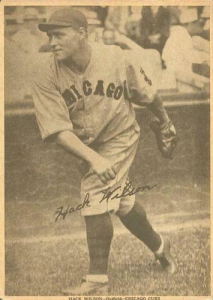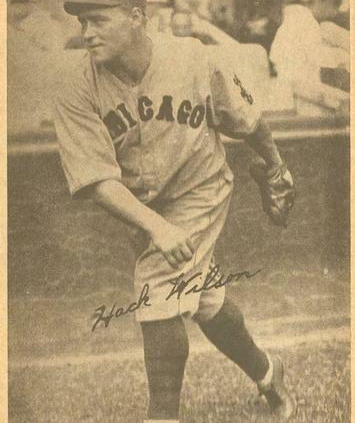July 26, 1930: Hack Wilson’s three-homer game spurs historic season
 Buoyed by a pregame band performance, Chicago Cubs center fielder Hack Wilson collected three home runs in a 16-2 blowout of the Philadelphia Phillies at the Baker Bowl on July 26, 1930. His accomplishment was noteworthy for two reasons. First, Wilson became the first Cubs player in the twentieth century with a three-homer game, a feat not accomplished since Ned Williamson and Cap Anson did it in 1884, when the franchise was known as the White Stockings.
Buoyed by a pregame band performance, Chicago Cubs center fielder Hack Wilson collected three home runs in a 16-2 blowout of the Philadelphia Phillies at the Baker Bowl on July 26, 1930. His accomplishment was noteworthy for two reasons. First, Wilson became the first Cubs player in the twentieth century with a three-homer game, a feat not accomplished since Ned Williamson and Cap Anson did it in 1884, when the franchise was known as the White Stockings.
Second, it ignited a season for the ages by Wilson that included a National League-record (since exceeded) 56 home runs and a major-league-record 191 runs-batted-in, a mark that still stood in 2023. “It was the spark that set Wilson on fire the rest of the season,” author Clifton Blue Parker wrote.1
The 30-year-old Wilson, who had racked up three home-run titles and an RBI crown in the previous four seasons, entered the final game of the Cubs’ three-game set in Philadelphia with outstanding numbers as Chicago’s cleanup hitter: a .335 batting average, 29 homers, and 93 RBIs in 94 games.
The Cubs, trailing the first-place Brooklyn Robins by a half-game, had batted out 28 runs and 33 hits in winning the first two games against the last-place Phillies. In the series finale, Chicago continued the hot hitting by jumping out to a nine-run lead by the second inning. Leadoff hitter Footsie Blair opened the first with a single to center. Two outs later, Wilson hit his 30th homer of the season, off right-handed starter Phil Collins, clearing the center-field fence.
Seven hits and two Phillies errors led to seven more runs in the second. Cubs starter Pat Malone homered over the right-field wall after Doc Farrell reached base on a force out. Two batters later, Woody English was safe on shortstop Tommy Thevenow’s error and advanced to second as Blair, who had doubled to center, crossed the plate. Kiki Cuyler drove in English with a single to right, making it a 6-0 game.
Wilson then clubbed his second home run of the game and 31st of the season. His drive off Collins cleared the 53-foot-high right-field fence near the foul line as the ball bounced down Broad Street afterward. Chicago’s lead was 8-0.
Another unearned run scored as Charlie Grimm was credited with a double when center fielder Tripp Sigman misjudged his fly ball, Gabby Hartnett walked, and third baseman Pinky Whitney made an errant throw to first after fielding Farrell’s grounder. Right-hander Claude Willoughby replaced Collins after Malone walked to load the bases. He retired Blair on a groundout for the third out.
The Phillies scored in the third and fourth innings to cut the deficit to 9-2. In the third, Lefty O’Doul walked and scored on Chuck Klein’s double to right. A season earlier, Klein had set a NL record with 43 home runs, and his 40 homers and 170 RBIs in 1930 ranked second to Wilson in both categories.
“When Wilson began to hit home runs the interest of the crowd fastened itself on Chuck Klein and they pleaded for him to come through with a couple of circuit clouts,” the Philadelphia Inquirer wrote. “Chuck tried to oblige them and swing viciously, but both his drives hit the screen and bounded back to the playing field.”2
Philadelphia’s fourth-inning run against Malone came when Bernie Friberg singled, took third on Thevenow’s double, and scored on Spud Davis’s sacrifice fly to center. Malone scattered 11 hits in picking up his 12th win of the season.
The Cubs responded to the Phillies’ mild rally with another run in the fifth, five more in the seventh, and a single tally in the eighth. In the fifth, Cuyler’s single drove in Blair, who had singled and stolen second.
Two innings later, Danny Taylor’s double scored English, who had doubled and gone to third on a groundout. After Grimm drove in two runs with a single, Hartnett hit a two-run blast into the left-field stands with one out.
Wilson capped the scoring with a tape-measure clout against Willoughby in the eighth inning with the bases empty and two outs – a drive that “carried almost to the tall brick chimney on the Reading [Railroad] tracks.”3 His 32nd home run of 1930 gave Wilson the NL lead and put him only four homers behind the New York Yankees’ Babe Ruth, who had set the major-league record three years earlier with 60.
Wilson finished the day with three hits in five at-bats, four runs scored, and five RBIs. Grimm went 3-for-6 with two runs scored and two RBIs. Blair had three hits in six at-bats and scored three times. Malone, a lifetime .188 hitter, went 3-for-4 with two RBIs. Four other Cubs had two hits apiece: English, Cuyler, Taylor, and Hartnett. Cuyler and Hartnett also collected two RBIs. All told, the Cubs knocked out 21 hits against the Phillies’ pitching staff, which has been described as the worst in major-league history.4
Wilson feasted off Phillies pitching in 1930, going 46-for-98 at the plate for a .469 batting average. His hits included 9 home runs, 8 doubles, and one triple. Thirty-eight of his record 191 RBIs came against Philadelphia. He had a .559 on-base percentage and an .847 slugging average against the Phillies.5
A lively ball helped Wilson and other hitters in 1930, too. “Perhaps the hitters of 1930 didn’t need a lively ball, but they got it,” Clifton Parker wrote. “This one used Australian yarn for the first time, literally taking the lively ball to new heights.”6
Wilson really heated up in August, smashing 13 homers and driving in 53 runs. He tied Klein’s NL record for home runs with a round-tripper on August 19. One week later, he called his shot, hit the record-breaking 44th homer against the Pittsburgh Pirates, and tied Ruth for the major-league lead.7 By the end of August, Wilson had accumulated 46 home runs, and the Cubs had a 5½-game lead over the second-place New York Giants.
Wilson clubbed his 50th homer of the season during the second game of a doubleheader at Philadelphia on September 15. By then, however, the Cubs had fallen into third place behind the Robins and the St. Louis Cardinals after dropping 11 of 18 games.
Eleven days later, the diminutive slugger’s 54th homer sparked a four-run rally in the seventh that carried the Cubs to a 7-5 victory over the Cincinnati Reds in Chicago. He also knocked in three runs on the last Ladies Day of the season, giving him 185 at that point. “There were not enough men or skimmers left, either one, so the women tore their scorecards into confetti and tossed them from the upper deck,” Roberts Ehrgott wrote in his 2013 book about owner P.K. Wrigley and the Cubs.
Wilson picked up his final two home runs of the season on September 27 in a 13-8 win over the Reds. Runs batted in 190 and 191 were a day later, during the last game of the year.
From his three-homer day on July 26 onward, Wilson batted .382 with 27 homers and 98 RBIs in just 61 games, slugging .790. The Cubs finished the season on a six-game winning streak but wound up in second place with a 90-64 record, two games behind the pennant-winning Cardinals.8 Chicago led the National League in attendance with 1,463,624.9
Acknowledgments
This article was fact-checked by Laura Peebles and copy-edited by Len Levin.
Sources
In addition to the sources listed in the Notes, the author used Baseball-Reference.com, Newspapers.com, and Retrosheet.org.
https://www.baseball-reference.com/boxes/PHI/PHI193007260.shtml
https://www.retrosheet.org/boxesetc/1930/B07260PHI1930.htm
Notes
1 Clifton Blue Parker, Fouled Away: The Baseball Tragedy of Hack Wilson (Jefferson, North Carolina: McFarland & Company, 2000), 105.
2 Stan Baumgartner, “Chicubs Massacre Pill and Gain 16 to 2 Victory Over Phillies Here,” Philadelphia Inquirer, July 27, 1930: 33. Klein also singled in the fifth.
3 Baumgartner.
4 Tom Ruane, “Modern Baseball’s Greatest-Hitting Team: The 1930 Phillies’ Opponents,” Baseball Research Journal, Society for American Baseball Research, Fall 2009. The Phillies’ starters had a 42-86 record and a 6.15 ERA in 991⅓ innings. The relief pitchers posted an 8.15 ERA in 383⅓ innings.
5 https://stathead.com/tiny/FZ3EQ. Ruane, “Modern Baseball’s Greatest-Hitting Team: The 1930 Phillies’ Opponents” shows 47-for-98 and correspondingly higher statistics. The source of the discrepancy is unknown, but could relate to an error Retrosheet found in the September 12, 1930, game https://www.retrosheet.org/boxesetc/1930/GD_PHI193009120.htm.
6 Parker, Fouled Away: The Baseball Tragedy of Hack Wilson, 95.
7 Roberts Ehrgott, Mr. Wrigley’s Ball Club: Chicago & the Cubs During the Jazz Age (Lincoln: University of Nebraska Press, 2013), 241.
8 Surrounded by rumors about his managerial demise, manager Joe McCarthy was replaced on September 25 by Rogers Hornsby, who led the Cubs to a third-place finish in 1931, then was replaced by Grimm after 99 games in 1932.
9 At the other end of the standings, the Phillies finished in last place with a 52-102 record under manager Burt Shotton and drew only 299,007 fans.
Additional Stats
Chicago Cubs 16
Philadelphia Phillies 2
Baker Bowl
Philadelphia, PA
Box Score + PBP:
Corrections? Additions?
If you can help us improve this game story, contact us.


